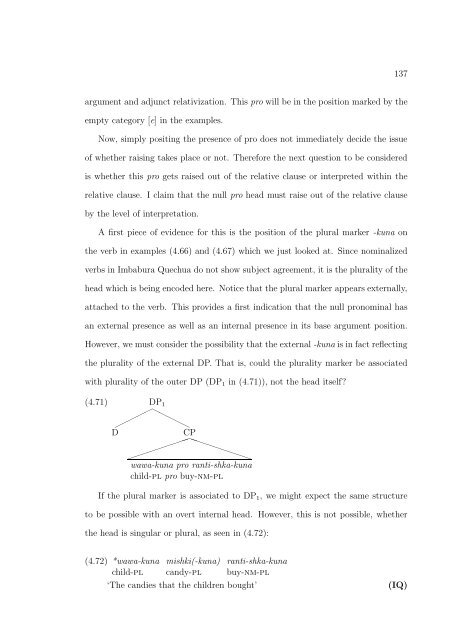the syntax and semantics of relativization and quantification
the syntax and semantics of relativization and quantification
the syntax and semantics of relativization and quantification
Create successful ePaper yourself
Turn your PDF publications into a flip-book with our unique Google optimized e-Paper software.
137<br />
argument <strong>and</strong> adjunct <strong>relativization</strong>. This pro will be in <strong>the</strong> position marked by <strong>the</strong><br />
empty category [e] in <strong>the</strong> examples.<br />
Now, simply positing <strong>the</strong> presence <strong>of</strong> pro does not immediately decide <strong>the</strong> issue<br />
<strong>of</strong> whe<strong>the</strong>r raising takes place or not. Therefore <strong>the</strong> next question to be considered<br />
is whe<strong>the</strong>r this pro gets raised out <strong>of</strong> <strong>the</strong> relative clause or interpreted within <strong>the</strong><br />
relative clause. I claim that <strong>the</strong> null pro head must raise out <strong>of</strong> <strong>the</strong> relative clause<br />
by <strong>the</strong> level <strong>of</strong> interpretation.<br />
A first piece <strong>of</strong> evidence for this is <strong>the</strong> position <strong>of</strong> <strong>the</strong> plural marker -kuna on<br />
<strong>the</strong> verb in examples (4.66) <strong>and</strong> (4.67) which we just looked at. Since nominalized<br />
verbs in Imbabura Quechua do not show subject agreement, it is <strong>the</strong> plurality <strong>of</strong> <strong>the</strong><br />
head which is being encoded here. Notice that <strong>the</strong> plural marker appears externally,<br />
attached to <strong>the</strong> verb. This provides a first indication that <strong>the</strong> null pronominal has<br />
an external presence as well as an internal presence in its base argument position.<br />
However, we must consider <strong>the</strong> possibility that <strong>the</strong> external -kuna is in fact reflecting<br />
<strong>the</strong> plurality <strong>of</strong> <strong>the</strong> external DP. That is, could <strong>the</strong> plurality marker be associated<br />
with plurality <strong>of</strong> <strong>the</strong> outer DP (DP 1 in (4.71)), not <strong>the</strong> head itself?<br />
(4.71) DP 1<br />
❍<br />
✟ ✟✟✟✟<br />
❍<br />
❍<br />
❍ ❍<br />
D<br />
✏ CP<br />
<br />
<br />
✏ ✏✏✏✏✏✏ wawa-kuna pro ranti-shka-kuna<br />
child-pl pro buy-nm-pl<br />
If <strong>the</strong> plural marker is associated to DP 1 , we might expect <strong>the</strong> same structure<br />
to be possible with an overt internal head. However, this is not possible, whe<strong>the</strong>r<br />
<strong>the</strong> head is singular or plural, as seen in (4.72):<br />
(4.72) *wawa-kuna<br />
child-pl<br />
mishki(-kuna)<br />
c<strong>and</strong>y-pl<br />
ranti-shka-kuna<br />
buy-nm-pl<br />
‘The c<strong>and</strong>ies that <strong>the</strong> children bought’<br />
(IQ)
















